Where you see this button
Spider Collector's Journal (18th page: 2008) Copyright © 2008 by Rod Crawford
Here's the 18th page of narratives of fun (and not so fun)
trips to collect spiders for research at the Burke
Museum, often accompanied by capable field volunteer Laurel Ramseyer. Most also appeared in Scarabogram, newsletter of "Scarabs:
The Bug Society." Dates of field trips head each paragraph. Maps showing
the location of sites within Washington state follow the grid system outlined
in the Washington
Spider Checklist. A large part of this year's trips were part of the Elwha River Project, led by Prof. Ted Pietsch (who also organized
the Kuril Islands and Sakhalin projects). The object was to do a baseline inventory
of the flora and fauna of the shores of the Elwha River for later comparison
when two dams and reservoirs on the river are removed. RETURN
TO INDEX
Where you see this button ![]() in a
field trip account, click it to get a page of collecting site photos!
in a
field trip account, click it to get a page of collecting site photos!
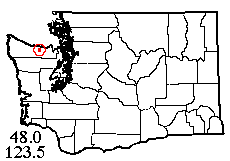 |
![]() 15-16 I 2008: It was before dawn on an icy morning after a snowy night
(just like the beginning of a Sherlock Holmes story) when Trevor Anderson showed
up to collect me and Ted Pietsch for our first assault on the Elwha River. Our
plan was not to actively collect but to scout out sites along the river where
the habitat was good and we could actually get access, so as to be prepared
for intensive collecting when the big project actually starts. First we drove
all the way up into the national park, where the road ends at Whiskey Bend trailhead
far above the river. No river access there without heavy-duty hiking (not on
today's agenda), but we sighted a surprisingly active black squirrel. After
much driving back and forth in search of a nonexistent road shown on the topo
map, we found a good multi-habitat site between the Elwha ranger station and
campground, habitats frozen solid today but with little snow on the ground.
Then downstream to easily locate a site on the lower reservoir (Lake Aldwell)
with good boat access to promising islands. Construction on a new bridge blocked
access to promising sites below the lower dam. A public trail on private land
at the river mouth took us to beautiful beach and swamp (both alder and willow)
habitats - with three different human polar bears surfing in January! After
a brief visit to the Lower Elwha Dam site (see album)
we retired to our rooms for the night, satisfied with the day and the amazingly
dry weather.
15-16 I 2008: It was before dawn on an icy morning after a snowy night
(just like the beginning of a Sherlock Holmes story) when Trevor Anderson showed
up to collect me and Ted Pietsch for our first assault on the Elwha River. Our
plan was not to actively collect but to scout out sites along the river where
the habitat was good and we could actually get access, so as to be prepared
for intensive collecting when the big project actually starts. First we drove
all the way up into the national park, where the road ends at Whiskey Bend trailhead
far above the river. No river access there without heavy-duty hiking (not on
today's agenda), but we sighted a surprisingly active black squirrel. After
much driving back and forth in search of a nonexistent road shown on the topo
map, we found a good multi-habitat site between the Elwha ranger station and
campground, habitats frozen solid today but with little snow on the ground.
Then downstream to easily locate a site on the lower reservoir (Lake Aldwell)
with good boat access to promising islands. Construction on a new bridge blocked
access to promising sites below the lower dam. A public trail on private land
at the river mouth took us to beautiful beach and swamp (both alder and willow)
habitats - with three different human polar bears surfing in January! After
a brief visit to the Lower Elwha Dam site (see album)
we retired to our rooms for the night, satisfied with the day and the amazingly
dry weather.
After breakfast
the next day, we went to the river mouth in the Lower Elwha Indian Reservation,
across from yesterday's beach site, and found a different swampy forest that
could be productive if the tribe turns out to be interested in participating.
Then much driving around (enlivened by Wrong-Way Anderson's habit of, shall
we say, exploring all options before taking the right road), all in vain search
for access to some state land along the lower river. Giving up on this, we found
one more good site on the east shore near the upper end of Lake Aldwell, then
put in pitfall traps in riparian maple on Forest Service land just south of
U.S. 101, reached via a dirt road that made me glad I had rubber boots. More
pitfalls were placed at the previous day's boat launch site and in a salal habitat
near the lower dam (see album) where I also took
a token leaf litter sample. Finally we returned to Port Angeles in search of
the office of the North Olympic Land Trust, almost as challenging to locate
as some of those river sites. But it was worthwhile since Allison Lutz of the
Trust gave us several leads for possible river access through private land.
All in all, a worthwhile scouting trip with 8 good study sites firmly located
(though only 6 spider species in the litter sample).
 |
![]() 27 II 2008: The need to service pitfall traps led me reluctantly to accompany
Trevor on the second Elwha trip on a day with 80% chance of rain in Port Angeles.
Sure enough, it was raining when we left Seattle at a relatively civilized hour.
But due to amazing luck, we had dry weather and even partly blue skies in the
Elwha valley all day! After a stop at the county courthouse for some land-parcel
files, we visited the last month's 3 pitfall trap sites. At the lower
dam site, all 5 traps were there but one had been visited by a mouse –
it contained mouse scats, a flea and lots of dirt – but this site still
trapped the best spiders, including one I've only taken once before. The three
traps at the boat launch site contained little; at the southernmost site, there
had evidently been frost heave in the saturated soil and several pitfall cups
had been squeezed out of the ground, but there was still a significant catch.
27 II 2008: The need to service pitfall traps led me reluctantly to accompany
Trevor on the second Elwha trip on a day with 80% chance of rain in Port Angeles.
Sure enough, it was raining when we left Seattle at a relatively civilized hour.
But due to amazing luck, we had dry weather and even partly blue skies in the
Elwha valley all day! After a stop at the county courthouse for some land-parcel
files, we visited the last month's 3 pitfall trap sites. At the lower
dam site, all 5 traps were there but one had been visited by a mouse –
it contained mouse scats, a flea and lots of dirt – but this site still
trapped the best spiders, including one I've only taken once before. The three
traps at the boat launch site contained little; at the southernmost site, there
had evidently been frost heave in the saturated soil and several pitfall cups
had been squeezed out of the ground, but there was still a significant catch.
We put in a 4th
pitfall series at a site just below the U.S. 101 river bridge (see
album), and stayed for a while to collect; I beat salal and conifers, hand-sorted
moss, and gathered another leaf litter sample while Trevor checked out logs
and swept along the river bank (using my collapsible pocket net). In just a
couple of hours we got 28 identifiable spider species (including the rare Bathyphantes
malkini), plus 2 being reared and a few more from the pitfalls. Meanwhile
Trevor got some varied-looking winter stoneflies. We ended an excellent day
by heading south into the national park and hiking a trail along the east side
of Lake Mills, finding at least three additional sites worth sampling later.
As we drove out of the park, deepening dusk brought out increasing numbers of
late-winter moths, probably Phigalia
plumogeraria. Trevor didn't even make any wrong turns today – but he
did get caught in a speed trap between Sequim and Port Discovery, ticketed for
driving a "furious" 68 mph.
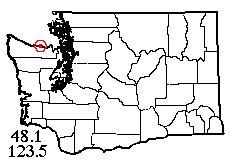 |
![]() 1-2 IV 2008: The entire team (including insect, fungus, lichen, moss
and spider collectors) of the Elwha River Biological Survey headed for the field
on a sunny Tuesday morning in several vehicles. The main party was 2 ferries
ahead of Laurel and me, so we expected to find them at the first site but instead
they had gone hunting our overnight cabins on Lake Crescent, and we started
the spider survey at the Elwha Dike beach trail alone. I started by sifting
14 species from litter of willow/alder thickets on the upper beach, including
an undescribed Oedothorax I've been wanting to get named, and a possibly
new Agroeca. Next, after putting in beach pitfalls, I beat 13 more species
from Douglas-fir foliage along the trail. Meanwhile, Laurel got nothing by beach
sweeping but some very good records under driftwood and by sorting beach wrack.
She beat shrubs along the trail while I tried the litter of an adjacent alder
swamp, getting surprisingly little, but overall we got 31 species here. Before
meeting the others for dinner, we sampled 2 of the 4 previously set pitfall
trap groups. The pitfalls at the lower dam site
are producing the best fauna, this time including some very interesting beetles.
The group dined in style at the [Dy]Nasty Chinese Restaurant before retiring
to unfancy but serviceable bunks.
1-2 IV 2008: The entire team (including insect, fungus, lichen, moss
and spider collectors) of the Elwha River Biological Survey headed for the field
on a sunny Tuesday morning in several vehicles. The main party was 2 ferries
ahead of Laurel and me, so we expected to find them at the first site but instead
they had gone hunting our overnight cabins on Lake Crescent, and we started
the spider survey at the Elwha Dike beach trail alone. I started by sifting
14 species from litter of willow/alder thickets on the upper beach, including
an undescribed Oedothorax I've been wanting to get named, and a possibly
new Agroeca. Next, after putting in beach pitfalls, I beat 13 more species
from Douglas-fir foliage along the trail. Meanwhile, Laurel got nothing by beach
sweeping but some very good records under driftwood and by sorting beach wrack.
She beat shrubs along the trail while I tried the litter of an adjacent alder
swamp, getting surprisingly little, but overall we got 31 species here. Before
meeting the others for dinner, we sampled 2 of the 4 previously set pitfall
trap groups. The pitfalls at the lower dam site
are producing the best fauna, this time including some very interesting beetles.
The group dined in style at the [Dy]Nasty Chinese Restaurant before retiring
to unfancy but serviceable bunks.
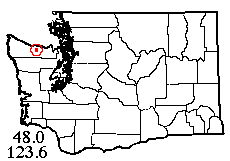 |
![]() Next morning the spider team (Laurel and I) separated from the main group (the
latter returning to the Lower Elwha) because I was eager to sample the remaining
old pitfall sites and get pitfalls in at a site near the Lake Mills boat launch
in the national park. We found a pleasant site just out of view from boat launch
parking lot and Boulder Creek trail without difficulty, with varied riparian
forest and small glades, on a cool but sunny day. Here at 600 feet elevation,
trees and shrubs were not in leaf yet, but litter, moss, logs and other habitats
produced 23 species. The invasive European crab spider Philodromus dispar
was well established here. From this remote spot, I easily reached my catsitter
in Seattle on Laurel's mobile phone – unfortunately she (the catsitter)
was incapacitated and I'd have to return home that day.
Next morning the spider team (Laurel and I) separated from the main group (the
latter returning to the Lower Elwha) because I was eager to sample the remaining
old pitfall sites and get pitfalls in at a site near the Lake Mills boat launch
in the national park. We found a pleasant site just out of view from boat launch
parking lot and Boulder Creek trail without difficulty, with varied riparian
forest and small glades, on a cool but sunny day. Here at 600 feet elevation,
trees and shrubs were not in leaf yet, but litter, moss, logs and other habitats
produced 23 species. The invasive European crab spider Philodromus dispar
was well established here. From this remote spot, I easily reached my catsitter
in Seattle on Laurel's mobile phone – unfortunately she (the catsitter)
was incapacitated and I'd have to return home that day.
![]() On the way back to the highway we'd spotted a nice looking gravel bar that turned
out to be on public land. Being unable to rejoin the others (they were on a
4-wheel drive road) we returned to the bar for the afternoon, hoping to get
the giant river wolf spider Pardosa lowriei. We did find a few (probably)
but they were immature, and surprisingly, none survived the trip back to Seattle
for rearing. But the habitat and riverbank did produce several good insects,
an impressive Scolopocryptops centipede, and a number of spiders, including
the rare theridiid Dipoena lana. This trip brought the project total
up to 69 spider species.
On the way back to the highway we'd spotted a nice looking gravel bar that turned
out to be on public land. Being unable to rejoin the others (they were on a
4-wheel drive road) we returned to the bar for the afternoon, hoping to get
the giant river wolf spider Pardosa lowriei. We did find a few (probably)
but they were immature, and surprisingly, none survived the trip back to Seattle
for rearing. But the habitat and riverbank did produce several good insects,
an impressive Scolopocryptops centipede, and a number of spiders, including
the rare theridiid Dipoena lana. This trip brought the project total
up to 69 spider species.
 |
![]() 11 IV 2008: I succeeded in getting contact info for the land managers
of the Lower Elwha Tribe, so Laurel
and I decided to try some sites on the reservation. On another delightful dry
spring day, we found the right people with no trouble, got several good tips
on sites and habitats and even a gate key! We drove up river on a gated (but
good) levee-top road until we reached a grassy field that Google Earth said
was very close to the river. Sure enough, there was just a thin belt of maple
and cottonwood between the field and what seems to be a side channel. This gave
us the field, two kinds of riparian leaf litter, and the river bank for collecting.
I found an especially rich deposit of maple litter and sifted the first 20 species
from that, followed by several others from cottonwood and grass litter. Meanwhile,
Laurel was getting species from grass foliage, under stones, under log bark,
and active in the field and on the river bank. By the time we had to return
the gate key, we had 41 species from this one site, including two species of
the shield-backed Ceratinella, two microspiders I didn't even recognize,
and surprising numbers of large Phidippus jumping spiders.
11 IV 2008: I succeeded in getting contact info for the land managers
of the Lower Elwha Tribe, so Laurel
and I decided to try some sites on the reservation. On another delightful dry
spring day, we found the right people with no trouble, got several good tips
on sites and habitats and even a gate key! We drove up river on a gated (but
good) levee-top road until we reached a grassy field that Google Earth said
was very close to the river. Sure enough, there was just a thin belt of maple
and cottonwood between the field and what seems to be a side channel. This gave
us the field, two kinds of riparian leaf litter, and the river bank for collecting.
I found an especially rich deposit of maple litter and sifted the first 20 species
from that, followed by several others from cottonwood and grass litter. Meanwhile,
Laurel was getting species from grass foliage, under stones, under log bark,
and active in the field and on the river bank. By the time we had to return
the gate key, we had 41 species from this one site, including two species of
the shield-backed Ceratinella, two microspiders I didn't even recognize,
and surprising numbers of large Phidippus jumping spiders.
![]() In the late afternoon we took the Warrior Trail (a public nature trail) from
the main road down toward the Elwha mouth, and collected near one of those wooden
birdwatchers' platforms where the trail ends on the banks of the estuary. A
sedge marsh here produced some promising spiders, all immature now but worth
a return trip; also an odd snake. A few additional species were taken in alder
and cottonwood litter. The forest here on the delta is rather unusual, many
small young trees and scattered big ones here and there among them. Laurel was
tired and light was going, so we went home with enough more spider species to
make the project total 89.
In the late afternoon we took the Warrior Trail (a public nature trail) from
the main road down toward the Elwha mouth, and collected near one of those wooden
birdwatchers' platforms where the trail ends on the banks of the estuary. A
sedge marsh here produced some promising spiders, all immature now but worth
a return trip; also an odd snake. A few additional species were taken in alder
and cottonwood litter. The forest here on the delta is rather unusual, many
small young trees and scattered big ones here and there among them. Laurel was
tired and light was going, so we went home with enough more spider species to
make the project total 89.
 |
![]() 23 IV 2008: Despite an ominous weather forecast, I succumbed to Trevor's
offer of a free ride while he went to sample a Malaise trap in the Rica Canyon
area of the upper Elwha. With us in the super-high-tech hybrid car from UW motor
pool was mycologist Luke Bayler. While they slogged into and out of the deep
canyon, I revisited one of our first pitfall trap sites, a maple-dominated floodplain
forest just upstream from highway 101 at a powerline right-of-way. The maple
litter still had plenty of spiders, notably Arcuphantes arcuatus and
the shield-backed Pelecopsis sculpta. Nine species were beaten from ferns.
The abundant moss had lots of individual spiders but most were the super-common
Theridion sexpunctatum. As the spring advances, our pitfall traps are
yielding more spiders than they did in winter. Rain started to sprinkle several
times but always stopped after a few drops; finally in midafternoon I got some
sun, and went across the river to the "Elwha
Bridge" site to sample the pitfalls there and try for ground-active
spiders in the big field. One, Scotinella sculleni, was new for the project.
Trevor and Luke returned, sampled another Malaise trap, and gathered in some
fungi I'd spotted earlier, before we paid a brief visit to a third pitfall site
and then headed home after a long day.
23 IV 2008: Despite an ominous weather forecast, I succumbed to Trevor's
offer of a free ride while he went to sample a Malaise trap in the Rica Canyon
area of the upper Elwha. With us in the super-high-tech hybrid car from UW motor
pool was mycologist Luke Bayler. While they slogged into and out of the deep
canyon, I revisited one of our first pitfall trap sites, a maple-dominated floodplain
forest just upstream from highway 101 at a powerline right-of-way. The maple
litter still had plenty of spiders, notably Arcuphantes arcuatus and
the shield-backed Pelecopsis sculpta. Nine species were beaten from ferns.
The abundant moss had lots of individual spiders but most were the super-common
Theridion sexpunctatum. As the spring advances, our pitfall traps are
yielding more spiders than they did in winter. Rain started to sprinkle several
times but always stopped after a few drops; finally in midafternoon I got some
sun, and went across the river to the "Elwha
Bridge" site to sample the pitfalls there and try for ground-active
spiders in the big field. One, Scotinella sculleni, was new for the project.
Trevor and Luke returned, sampled another Malaise trap, and gathered in some
fungi I'd spotted earlier, before we paid a brief visit to a third pitfall site
and then headed home after a long day.
 |
![]() 29 IV - 1 V 2008: The main body of the biological survey team headed
for the field on Monday the 28th and suffered through the wettest, most miserable
day of the project. Laurel and I (with insect collector Royce Anderson) followed
on the 28th, a wet day but only moderately miserable by comparison! A patch
of blue sky enticed me with the prospect of collecting active beach spiders,
but it was cold, wet and windy there so we proceeded to the Lower
Dam pitfall site where Laurel found two dry salal bushes and got a new jumping
spider for the project, Phanias albeolus. Then we located without trouble
the lower trailhead for the West
Elwha Trail, the lowest of the Park Service trails in this area. Though
right across the river from houses, campgrounds and so forth, the trailside
terrain is very wild. The trouble was, a cloudburst complete with lots of hail
had visited the site just before we did! We slogged on through the mud to reach
a cliff area where we hoped to collect under rocks. Rocks were found, but not
a great many spiders under them. This potentially lovely site (see
album) will have to be revisited when dry. Josephine Pederson, a friendly
landowner across the river, was lending the expedition her large heated yurt;
we stopped off there to settle in, then went to sample the Lake
Mills pitfalls before calling it a day and heading to town for dinner.
29 IV - 1 V 2008: The main body of the biological survey team headed
for the field on Monday the 28th and suffered through the wettest, most miserable
day of the project. Laurel and I (with insect collector Royce Anderson) followed
on the 28th, a wet day but only moderately miserable by comparison! A patch
of blue sky enticed me with the prospect of collecting active beach spiders,
but it was cold, wet and windy there so we proceeded to the Lower
Dam pitfall site where Laurel found two dry salal bushes and got a new jumping
spider for the project, Phanias albeolus. Then we located without trouble
the lower trailhead for the West
Elwha Trail, the lowest of the Park Service trails in this area. Though
right across the river from houses, campgrounds and so forth, the trailside
terrain is very wild. The trouble was, a cloudburst complete with lots of hail
had visited the site just before we did! We slogged on through the mud to reach
a cliff area where we hoped to collect under rocks. Rocks were found, but not
a great many spiders under them. This potentially lovely site (see
album) will have to be revisited when dry. Josephine Pederson, a friendly
landowner across the river, was lending the expedition her large heated yurt;
we stopped off there to settle in, then went to sample the Lake
Mills pitfalls before calling it a day and heading to town for dinner.
 |
![]() Next morning the spider team (Laurel and I augmented by project leader Ted Pietsch)
headed for the beach in sunshine. My plan of collecting beach-active jumping
spiders had to be postponed again due to cold wind. The beach pitfalls were
productive and Ted found some great-looking specimens in litter of the beach
meadow, mostly immature as it turned out, so we'll just have to keep going back
to that beach! Two wolf spiders, an orbweaver and assorted other species were
added to the list, mainly by Laurel. Ted and I then headed for the river bluffs
just upstream from the beach in search of more under-rock fauna, which we found
(Ted added yet another wolf spider species) as well as some webs on the face
of the cobble-studded sand/silt cliff. Conifer foliage sampling in this area
by all three of us added some more species. Laurel needed to head for home,
so Ted and I returned to the Pederson yurt where I sampled moss from a nearby
river island, swept some grass and beat cedar foliage until interrupted by today's
token rain shower. Mrs. Pederson was nice enough to let me hunt for house spiders
in her house and garage.
Next morning the spider team (Laurel and I augmented by project leader Ted Pietsch)
headed for the beach in sunshine. My plan of collecting beach-active jumping
spiders had to be postponed again due to cold wind. The beach pitfalls were
productive and Ted found some great-looking specimens in litter of the beach
meadow, mostly immature as it turned out, so we'll just have to keep going back
to that beach! Two wolf spiders, an orbweaver and assorted other species were
added to the list, mainly by Laurel. Ted and I then headed for the river bluffs
just upstream from the beach in search of more under-rock fauna, which we found
(Ted added yet another wolf spider species) as well as some webs on the face
of the cobble-studded sand/silt cliff. Conifer foliage sampling in this area
by all three of us added some more species. Laurel needed to head for home,
so Ted and I returned to the Pederson yurt where I sampled moss from a nearby
river island, swept some grass and beat cedar foliage until interrupted by today's
token rain shower. Mrs. Pederson was nice enough to let me hunt for house spiders
in her house and garage.
 |
![]() May Day gave us the best weather of the trip. Ted and I, with mycologist Luke,
went back to the lower dam pitfall site to sample
additional habitats. Trevor had told me of a side trail leading to a rock-climbers'
cliff, and sure enough, there were spiders under the rocks there. Meanwhile,
Ted was sorting litter on a steep grassy hillside near the dam and added the
jumping spider Eris militaris to the list. I found another wolf spider
species to rear in this area, as well as 2 fungi Luke didn't have yet. Ted and
I beat salal and Douglas-fir foliage for a few more records, and additional
species were swept from the grass and sifted from conifer litter. We headed
for home in mid-afternoon after only a few droplets of rain, with over 111 spider
species now recorded from the Elwha River.
May Day gave us the best weather of the trip. Ted and I, with mycologist Luke,
went back to the lower dam pitfall site to sample
additional habitats. Trevor had told me of a side trail leading to a rock-climbers'
cliff, and sure enough, there were spiders under the rocks there. Meanwhile,
Ted was sorting litter on a steep grassy hillside near the dam and added the
jumping spider Eris militaris to the list. I found another wolf spider
species to rear in this area, as well as 2 fungi Luke didn't have yet. Ted and
I beat salal and Douglas-fir foliage for a few more records, and additional
species were swept from the grass and sifted from conifer litter. We headed
for home in mid-afternoon after only a few droplets of rain, with over 111 spider
species now recorded from the Elwha River.
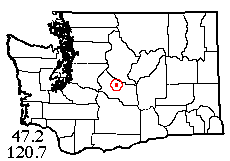 |
![]() 22 V 2008: Warm sunny weather for the next phase of Elwha River collecting
still eluded us, so Laurel and I took a "sun break" from that project
in eastern Washington. True to form, we left the clouds behind on our way from
Easton to Cle Elum. The weather forecast had said "breezy" but when
we reached our goal, a habitat patch near Swauk Prairie Cemetery, we'd describe
conditions as downright windy. I found enough sheltered spots to sweep 6 species
from grass, then got lucky with a hawthorn thicket that had 9 interesting species
in leaf litter. I wanted to conclude the visit by seeking habitat-limited species
under Ponderosa pine bark scales, but the wind blew my scales away as fast as
I scraped them loose! Meanwhile, Laurel found one wolf spider species running
despite the wind chill, beat a few species from vegetation and found an adult
Callobius under wood. But far more than this, she discovered a new habitat
and collecting technique! It seems that if the large, fallen cones of Ponderosa
pine are tapped over a cloth, they yield up numbers of spiders including some
rarities like members of the crab spider genus Ebo; we'll have to try
this again.
22 V 2008: Warm sunny weather for the next phase of Elwha River collecting
still eluded us, so Laurel and I took a "sun break" from that project
in eastern Washington. True to form, we left the clouds behind on our way from
Easton to Cle Elum. The weather forecast had said "breezy" but when
we reached our goal, a habitat patch near Swauk Prairie Cemetery, we'd describe
conditions as downright windy. I found enough sheltered spots to sweep 6 species
from grass, then got lucky with a hawthorn thicket that had 9 interesting species
in leaf litter. I wanted to conclude the visit by seeking habitat-limited species
under Ponderosa pine bark scales, but the wind blew my scales away as fast as
I scraped them loose! Meanwhile, Laurel found one wolf spider species running
despite the wind chill, beat a few species from vegetation and found an adult
Callobius under wood. But far more than this, she discovered a new habitat
and collecting technique! It seems that if the large, fallen cones of Ponderosa
pine are tapped over a cloth, they yield up numbers of spiders including some
rarities like members of the crab spider genus Ebo; we'll have to try
this again.
![]() I had other sites pre-selected for further collecting in this area, but all
proved to be on posted private roads. However, where Red Bridge Road crosses
the Teanaway River, we found no signs blocking our way to lush streamside cottonwood
groves and natural gravel bars and mud flats. The 10 species I took here from
cottonwood litter had only one in common with the 9 found earlier in hawthorn
litter! A few more were found in understory foliage and under bark. Laurel got
two good jumping spider species active on the riverbank, plus the common wolf
spider Pardosa tristis and the extremely rare Pardosa steva, only
taken 3 times in this state. Altogether our take for the day was 35 species,
not bad at all for a few hours in high winds. We both agreed that our post-trip
treat at Mountain High Burgers in Easton definitely hit the spot. And yes, the
rain resumed as soon as we passed the Pass westward.
I had other sites pre-selected for further collecting in this area, but all
proved to be on posted private roads. However, where Red Bridge Road crosses
the Teanaway River, we found no signs blocking our way to lush streamside cottonwood
groves and natural gravel bars and mud flats. The 10 species I took here from
cottonwood litter had only one in common with the 9 found earlier in hawthorn
litter! A few more were found in understory foliage and under bark. Laurel got
two good jumping spider species active on the riverbank, plus the common wolf
spider Pardosa tristis and the extremely rare Pardosa steva, only
taken 3 times in this state. Altogether our take for the day was 35 species,
not bad at all for a few hours in high winds. We both agreed that our post-trip
treat at Mountain High Burgers in Easton definitely hit the spot. And yes, the
rain resumed as soon as we passed the Pass westward.
5-6 VI 2008: The weather still hadn't improved, but pitfall traps in place over a month definitely had to be serviced, so I went back to the Elwha with Ted Pietsch and two Russian visitors: Viktor Bogatov, malacologist from Vladivostok and chief of the Russian contingent in the Kuril Islands Project, and his son Slava (Yaroslav), now an engineering student in Maryland. This time we weren't lucky; as predicted, it stayed too wet for general spider collecting both days. However, I did get all the pitfalls switched, with some attrition: 1 stepped on by a deer and 3 of the beach traps destroyed by some animal that actually left tooth holes in the cups! I gathered 2 meadow litter samples from pitfall sites and took them back to our new HQ, a small house in Port Angeles that Trevor had rented for the season. Unexpectedly, his non-participant wife was also there telecommuting, and even their cat June! Viktor was luckier than I, since his snail collecting technique works even in the rain: take a handful of wet litter, wash it in a bucket of stream or lake water and nab the snails that float to the surface. His best catch was at Lower Elwha Dam where the pitfalls also consistently produce the best spiders and insects. All was not in vain, for the trap and litter catches boosted the Elwha spider list to at least 125 species.
 |
![]() 19 VI 2008: After various delays, Laurel and I got back to the Elwha for a long-planned visit to add late spring spider species to the project list. After checking in with the always-helpful Lower Elwha Tribe, I headed down the Warrior Trail while Laurel sneaked a photo of me from behind (see album). In sweeping the sedge, grass and herbs where only immatures had been taken in April, I added Tetragnatha extensa and Erigone zographica to the list while chatting with a local resident reading on the trail-end platform, who actually knew a bit more about spiders than her town cousins! Then we hiked up the dike road and down a side trail to a previously unvisited grassy meadow, complete with piles of logs being stockpiled to make salmon habitat in the river. Eighteen species were taken there mostly from vegetation, including 3 new to the list. Two more came from a brief visit to the grassy field at the lower dam.
19 VI 2008: After various delays, Laurel and I got back to the Elwha for a long-planned visit to add late spring spider species to the project list. After checking in with the always-helpful Lower Elwha Tribe, I headed down the Warrior Trail while Laurel sneaked a photo of me from behind (see album). In sweeping the sedge, grass and herbs where only immatures had been taken in April, I added Tetragnatha extensa and Erigone zographica to the list while chatting with a local resident reading on the trail-end platform, who actually knew a bit more about spiders than her town cousins! Then we hiked up the dike road and down a side trail to a previously unvisited grassy meadow, complete with piles of logs being stockpiled to make salmon habitat in the river. Eighteen species were taken there mostly from vegetation, including 3 new to the list. Two more came from a brief visit to the grassy field at the lower dam.
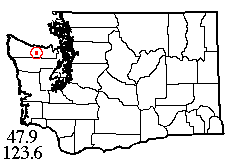 |
![]() Rather than do other short stops as originally planned, we decided to reserve our time and energies for the 2-mile hike to Boulder Creek at the upper end of Lake Mills, which we hadn't reached before due to weather. The trail goes through very interesting forest, most of the trees less than 100 years old but with a significant minority of old-growth giants with obvious fire scars and in one case a classic spiral lightning scar! Not hard for a forest detective to figure out what happened here. I'd wondered why the trail ends at Boulder Creek. Well, this creek is in a good-sized canyon that the trail builders probably didn't feel like bridging. Laurel made her way to the bottom where the canyon walls provided good botanical photo-ops while I collected in the forest above, getting Xysticus pretiosus from the conifer foliage, 7 species from moss, 3 more from conifer litter, and 8 from understory foliage. Laurel added several from streamside habitats including the uncommon gnaphosid Drassodes neglectus, found under stones and in the crevice of a split log. While we were there a party of 4 young people reached the canyon, stayed perhaps 10 minutes, then turned right around and headed out! We ended with 21 species from this site and 134 from the Elwha project. Other than a few mosquitos, nothing interfered with our enjoyment of a productive day.
Rather than do other short stops as originally planned, we decided to reserve our time and energies for the 2-mile hike to Boulder Creek at the upper end of Lake Mills, which we hadn't reached before due to weather. The trail goes through very interesting forest, most of the trees less than 100 years old but with a significant minority of old-growth giants with obvious fire scars and in one case a classic spiral lightning scar! Not hard for a forest detective to figure out what happened here. I'd wondered why the trail ends at Boulder Creek. Well, this creek is in a good-sized canyon that the trail builders probably didn't feel like bridging. Laurel made her way to the bottom where the canyon walls provided good botanical photo-ops while I collected in the forest above, getting Xysticus pretiosus from the conifer foliage, 7 species from moss, 3 more from conifer litter, and 8 from understory foliage. Laurel added several from streamside habitats including the uncommon gnaphosid Drassodes neglectus, found under stones and in the crevice of a split log. While we were there a party of 4 young people reached the canyon, stayed perhaps 10 minutes, then turned right around and headed out! We ended with 21 species from this site and 134 from the Elwha project. Other than a few mosquitos, nothing interfered with our enjoyment of a productive day.
 |
![]() 30 VI 2008: A few miles down the dry side of the Stevens Pass Highway, a short side road leads to a hiking trail up Whitepine Creek, oddly unpopular judging from the small number of Google hits. With a weather report that sounded good save for a 20% chance of thunderstorms, Laurel and I arrived at the trailhead in full sunshine. She wanted to explore further the pine cone habitat she'd discovered, so ventured into an open area to one side of the trailhead she dubbed the "pine barrens" that featured three pine species. I sampled conifer foliage, shrubs, understory and conifer litter all within sight of the trailhead parking lot, gleaning 22 spider species by the time Laurel returned from the pines with a further 6, of which 3 from the cones have yet to be identified: once more this seems to be a promising habitat. By this time, some big clouds had come over delivering a few sprinkles that soon dried. I headed back down the road to a small stream we'd crossed, to sift broadleaf litter and sweep riparian understory. That understory was not destined to be swept; while I sifted under a conveniently thick tree, the clouds burst, leaving the foliage thoroughly wet. The alder-cottonwood litter and some rock-turning by Laurel added 5 more species including a rare Cybaeopsis. Finally, the rain having stopped again, we repaired to a nearby "borrow pit" to collect under rocks and wood, which site added a final 6 species including Steatoda albomaculata, Callilepis eremella, Phidippus johnsonii, and a large range extension for the gorgeous little jumping spider Habronattus sansoni (see album). A fine day, with not one human sighted in the woods, had a fitting conclusion with a luscious hamburger at Zeke's, traditional collector's pit stop just east of Gold Bar.
30 VI 2008: A few miles down the dry side of the Stevens Pass Highway, a short side road leads to a hiking trail up Whitepine Creek, oddly unpopular judging from the small number of Google hits. With a weather report that sounded good save for a 20% chance of thunderstorms, Laurel and I arrived at the trailhead in full sunshine. She wanted to explore further the pine cone habitat she'd discovered, so ventured into an open area to one side of the trailhead she dubbed the "pine barrens" that featured three pine species. I sampled conifer foliage, shrubs, understory and conifer litter all within sight of the trailhead parking lot, gleaning 22 spider species by the time Laurel returned from the pines with a further 6, of which 3 from the cones have yet to be identified: once more this seems to be a promising habitat. By this time, some big clouds had come over delivering a few sprinkles that soon dried. I headed back down the road to a small stream we'd crossed, to sift broadleaf litter and sweep riparian understory. That understory was not destined to be swept; while I sifted under a conveniently thick tree, the clouds burst, leaving the foliage thoroughly wet. The alder-cottonwood litter and some rock-turning by Laurel added 5 more species including a rare Cybaeopsis. Finally, the rain having stopped again, we repaired to a nearby "borrow pit" to collect under rocks and wood, which site added a final 6 species including Steatoda albomaculata, Callilepis eremella, Phidippus johnsonii, and a large range extension for the gorgeous little jumping spider Habronattus sansoni (see album). A fine day, with not one human sighted in the woods, had a fitting conclusion with a luscious hamburger at Zeke's, traditional collector's pit stop just east of Gold Bar.
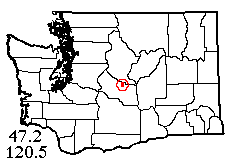 |
![]() 30 VII 2008: For various reasons I hadn't been in the field for a month and the lateness of the season dictated a really high elevation area. Table Mountain north of Ellensburg (where I had an old sample of 6 species to supplement) has several square miles between 5000 and 6000 feet above sea level. The day was beautiful and so was the mountain meadow where Laurel and I first stopped to collect (though close inspection showed degradation from overgrazing). Sweeping here produced 5 spider species, conifer foliage added one, and rock-turning one more. A trail passing through our next site called "Wilson Stock Driveway" hints at the source of the overgrazing. This site has an area of sagebrush giving way to lush riparian meadow with dry mountain meadow on the far side, and a forest area of pine and spruce containing an old, woodrat-inhabited "Riders Cabin." From all this, we added 6 species to the prior sample. Several species were taken at a roadside grassy area, but all duplicated previous records. Finally, we stopped at the first grove of big ponderosa pines we saw on our way down the mountain for Laurel's new pine-cone collecting technique. But everything she got was juvenile. There was a great view of Reecer Canyon and the Kittitas Valley from the site, though. High though this plateau is, the season here was clearly too far advanced for good collecting; we'll have to try again a few weeks earlier in some future year.
30 VII 2008: For various reasons I hadn't been in the field for a month and the lateness of the season dictated a really high elevation area. Table Mountain north of Ellensburg (where I had an old sample of 6 species to supplement) has several square miles between 5000 and 6000 feet above sea level. The day was beautiful and so was the mountain meadow where Laurel and I first stopped to collect (though close inspection showed degradation from overgrazing). Sweeping here produced 5 spider species, conifer foliage added one, and rock-turning one more. A trail passing through our next site called "Wilson Stock Driveway" hints at the source of the overgrazing. This site has an area of sagebrush giving way to lush riparian meadow with dry mountain meadow on the far side, and a forest area of pine and spruce containing an old, woodrat-inhabited "Riders Cabin." From all this, we added 6 species to the prior sample. Several species were taken at a roadside grassy area, but all duplicated previous records. Finally, we stopped at the first grove of big ponderosa pines we saw on our way down the mountain for Laurel's new pine-cone collecting technique. But everything she got was juvenile. There was a great view of Reecer Canyon and the Kittitas Valley from the site, though. High though this plateau is, the season here was clearly too far advanced for good collecting; we'll have to try again a few weeks earlier in some future year.
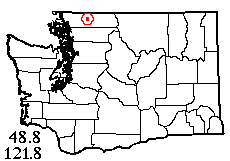 |
![]() 5 VIII 2008: Ever since my friend Della Scott got a "Zipcar" membership, we've been scheming how to get a collecting trip out of her new access to wheels. The time finally came at the tail end of summer collecting season. I picked a North Cascades area NW of Mount Baker where snow persists late and I had an 8-species prior sample, hoping for the best. First we drove up to the Baker Vista picnic area for lunch; it certainly has a great view. Then back to a bridge over an un-named tributary of Grouse Creek, where I scrambled down into the ravine and beat a few species from riparian salmonberry. The roadside verge here, with lots of red paintbrush still in bloom, brought the total to only 5 species, so we moved on to another pre-selected site, an old roadside rock quarry. A family was picnicking here and the kids said they'd seen spiders, but I found nothing mature on the cliff or under rocks. Several additional species (mainly orbweavers) were taken from vegetation and aerial webs here, though. Then I tried sifting conifer litter from among jumbled logs in the adjacent forest, which really saved the day: 8 additional spider species in one sample. The grand total of 23 species was unspectacular but adequate. Biting flies were few, considering the season, and nothing at all went wrong beyond a traffic slowdown in Everett on the way home.
5 VIII 2008: Ever since my friend Della Scott got a "Zipcar" membership, we've been scheming how to get a collecting trip out of her new access to wheels. The time finally came at the tail end of summer collecting season. I picked a North Cascades area NW of Mount Baker where snow persists late and I had an 8-species prior sample, hoping for the best. First we drove up to the Baker Vista picnic area for lunch; it certainly has a great view. Then back to a bridge over an un-named tributary of Grouse Creek, where I scrambled down into the ravine and beat a few species from riparian salmonberry. The roadside verge here, with lots of red paintbrush still in bloom, brought the total to only 5 species, so we moved on to another pre-selected site, an old roadside rock quarry. A family was picnicking here and the kids said they'd seen spiders, but I found nothing mature on the cliff or under rocks. Several additional species (mainly orbweavers) were taken from vegetation and aerial webs here, though. Then I tried sifting conifer litter from among jumbled logs in the adjacent forest, which really saved the day: 8 additional spider species in one sample. The grand total of 23 species was unspectacular but adequate. Biting flies were few, considering the season, and nothing at all went wrong beyond a traffic slowdown in Everett on the way home.
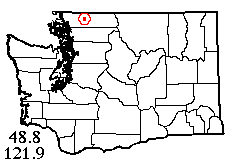 |
![]() 14 VIII 2008: I thought I should quit while I was ahead, but Laurel hadn't quite slaked her field-trip thirst for the summer and talked me into one more. I'm glad she did. Since I'd done fairly well in the Mt. Baker area the previous week, I decided on sampling an adjacent area, containing accessible, 5076-foot Lookout Mountain. Hedging our bets, we stopped first down at the Glacier Ranger Station to get a few lowland species. Luck was with us to the extent of 4 species on buildings and 6 more from an adjacent roadside field. Then on up into the mountains, and after "photo op" stops en route, we stopped at a mountain meadow in the saddle between the two peaks of Lookout Mountain (incidentally with a great view). Here, the biting flies I'd evaded last week caught up with us: rhagionids (which find it really difficult to pierce human skin but are very willing to have a try), a few horse and deer flies, and mosquitos that increased as the day wore on. Fortunately, I'd brought a brand new bottle of DEET! Remembering my success with conifer litter last week, I concentrated on that at this site. Much of this area has been logged, but a small patch of old growth had excellent litter that produced 10 spider species, including what at first looked like the second specimen of Sisicottus aenigmaticus known to exist, but wasn't. Laurel got 5 species from vegetation here and even some mature Pardosa metlakatla wolf spiders were active. Lastly, we climbed to the south summit (warm work in this August heat wave) and were rewarded by a beautiful treeline meadow with tall sedge, heather and grass, plus mountain hemlock and true firs along the edge. The meadow foliage sample included very interesting species: Philodromus mysticus, Lepthyphantes mercedes, and Theridion saanichum. Pityohyphantes in the conifer foliage sample appeared to be two unfamiliar species, but this too proved deceptive. Laurel got two further wolf spider species here, including a nice record of Arctosa alpigena. There was even a big snowpatch visible, though the hike over to it was not repaid with any further spider species. But 36 species in all from a mid-August trip is really remarkable, even unprecedented. Thank you, Lookout Mountain!
14 VIII 2008: I thought I should quit while I was ahead, but Laurel hadn't quite slaked her field-trip thirst for the summer and talked me into one more. I'm glad she did. Since I'd done fairly well in the Mt. Baker area the previous week, I decided on sampling an adjacent area, containing accessible, 5076-foot Lookout Mountain. Hedging our bets, we stopped first down at the Glacier Ranger Station to get a few lowland species. Luck was with us to the extent of 4 species on buildings and 6 more from an adjacent roadside field. Then on up into the mountains, and after "photo op" stops en route, we stopped at a mountain meadow in the saddle between the two peaks of Lookout Mountain (incidentally with a great view). Here, the biting flies I'd evaded last week caught up with us: rhagionids (which find it really difficult to pierce human skin but are very willing to have a try), a few horse and deer flies, and mosquitos that increased as the day wore on. Fortunately, I'd brought a brand new bottle of DEET! Remembering my success with conifer litter last week, I concentrated on that at this site. Much of this area has been logged, but a small patch of old growth had excellent litter that produced 10 spider species, including what at first looked like the second specimen of Sisicottus aenigmaticus known to exist, but wasn't. Laurel got 5 species from vegetation here and even some mature Pardosa metlakatla wolf spiders were active. Lastly, we climbed to the south summit (warm work in this August heat wave) and were rewarded by a beautiful treeline meadow with tall sedge, heather and grass, plus mountain hemlock and true firs along the edge. The meadow foliage sample included very interesting species: Philodromus mysticus, Lepthyphantes mercedes, and Theridion saanichum. Pityohyphantes in the conifer foliage sample appeared to be two unfamiliar species, but this too proved deceptive. Laurel got two further wolf spider species here, including a nice record of Arctosa alpigena. There was even a big snowpatch visible, though the hike over to it was not repaid with any further spider species. But 36 species in all from a mid-August trip is really remarkable, even unprecedented. Thank you, Lookout Mountain!
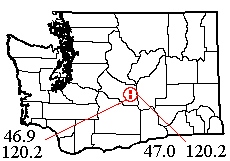 |
![]() 9 X 2008: For our first fall collecting trip, we chose to go to eastern Washington where I seldom get to collect in fall; for some reason butterfly collectors won't go there when nothing is flying. I wanted to complete old partial samples in at least one of two areas first visited way back in 1972-73. As recently as 1985, one could drive up Johnson Canyon (south of I-90 in eastern Kittitas County) as far as the ghost town of Boylston. But now that area is in the army's Yakima Training Center; we met a restricted area gate 4.4 miles short of Boylston and 3.5 from our intended collecting site. A call to the authorities on Laurel's mobile phone produced no immediate relief, so we decided to try for a sample in the very limited area available outside the gate. An unpromising field of largely non-native dry grass yielded only Dictyna, apparently 3 species at first glance, but all finally proved to be Dictyna coloradensis. A public restroom building for the nearby John Wayne Pioneer Trail contained two Xysticus gulosus, two black widows, and a dead but identifiable Hololena in one of the widow webs. Between us and the adjacent freeway was a currently disused irrigation canal with a nice wetland in the bottom where willow litter produced 5 species, and riparian foliage 5 more. Not a great collection in itself, but very worthwhile because it brought this area up to 24 species from the previous 10. Several deer skeletons littered the roadside just outside the gate.
9 X 2008: For our first fall collecting trip, we chose to go to eastern Washington where I seldom get to collect in fall; for some reason butterfly collectors won't go there when nothing is flying. I wanted to complete old partial samples in at least one of two areas first visited way back in 1972-73. As recently as 1985, one could drive up Johnson Canyon (south of I-90 in eastern Kittitas County) as far as the ghost town of Boylston. But now that area is in the army's Yakima Training Center; we met a restricted area gate 4.4 miles short of Boylston and 3.5 from our intended collecting site. A call to the authorities on Laurel's mobile phone produced no immediate relief, so we decided to try for a sample in the very limited area available outside the gate. An unpromising field of largely non-native dry grass yielded only Dictyna, apparently 3 species at first glance, but all finally proved to be Dictyna coloradensis. A public restroom building for the nearby John Wayne Pioneer Trail contained two Xysticus gulosus, two black widows, and a dead but identifiable Hololena in one of the widow webs. Between us and the adjacent freeway was a currently disused irrigation canal with a nice wetland in the bottom where willow litter produced 5 species, and riparian foliage 5 more. Not a great collection in itself, but very worthwhile because it brought this area up to 24 species from the previous 10. Several deer skeletons littered the roadside just outside the gate.
![]() We spent the last hours of daylight on Parke Creek (NE of Kittitas and N of Whiskey Dick Mountain), where I had 9 old records from the third spider collecting trip of my career way back in 1972. Luckily, none of the several active rainclouds we could see passed over us. We knew we were on private land (the "County Road Ends" sign was about 2 miles back) when we reached a good spot, but private owners are more amenable to spider collecting than the Army and made no difficulties when Laurel asked permission. Much of this canyon is heavily overgrazed (see album) but the fenced area where we collected was delightfully un-chomped; some of the riparian vegetation was really rich and diverse. The leaf litter alone produced 13 spider species and an unfamiliar polydesmid millipede. None of the foliage was as productive, but there was enough of it that we got 23 species at this site, making 30 with the old sample. The best spiders taken here were an unfamiliar Scotinotylus, very common in the leaf litter, and yet another new Disembolus swept in the ungrazed meadow. Social wasps were just barely hanging on here (only one hornet peeked out of a disintegrating nest). Both Laurel and I got our feet wet in unexpected wetlands in the streamside glades. A young lady drove through on a sort of golf cart leading a large pack of (friendly) dogs on leads; exercising them for a local breeder. The hills were reddening when we headed for home, with a nice red and blue sunset greeting us just as we got on the freeway. I continued my tradition of treating myself to a Mountain High Hamburger in Easton, ending a fine, productive day.
We spent the last hours of daylight on Parke Creek (NE of Kittitas and N of Whiskey Dick Mountain), where I had 9 old records from the third spider collecting trip of my career way back in 1972. Luckily, none of the several active rainclouds we could see passed over us. We knew we were on private land (the "County Road Ends" sign was about 2 miles back) when we reached a good spot, but private owners are more amenable to spider collecting than the Army and made no difficulties when Laurel asked permission. Much of this canyon is heavily overgrazed (see album) but the fenced area where we collected was delightfully un-chomped; some of the riparian vegetation was really rich and diverse. The leaf litter alone produced 13 spider species and an unfamiliar polydesmid millipede. None of the foliage was as productive, but there was enough of it that we got 23 species at this site, making 30 with the old sample. The best spiders taken here were an unfamiliar Scotinotylus, very common in the leaf litter, and yet another new Disembolus swept in the ungrazed meadow. Social wasps were just barely hanging on here (only one hornet peeked out of a disintegrating nest). Both Laurel and I got our feet wet in unexpected wetlands in the streamside glades. A young lady drove through on a sort of golf cart leading a large pack of (friendly) dogs on leads; exercising them for a local breeder. The hills were reddening when we headed for home, with a nice red and blue sunset greeting us just as we got on the freeway. I continued my tradition of treating myself to a Mountain High Hamburger in Easton, ending a fine, productive day.
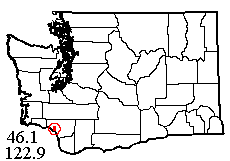 |
30-31 X 2008: Of spider collecting trips, those that "gang aft agley" are those planned farthest in advance. Some time ago I arranged to travel to Longview, Washington to give a lecture for the local Audubon Society and collect at two sites managed by a local land trust. Because of the lecture, the date had to be set at least a month ahead. Guess what, a week of lovely weather came to an end the day of the lecture. But my trip was not in vain; not only did I get a great audience for my lecture (and an attendant "lab" session at Lower Columbia College), but on the train trip down I passed a number of promising sites along the Amtrak route, and, GPS in hand, took notes for the future. I'd gathered 8 species from my hostess's home in Longview, and before my trip home on rainy Halloween Friday, we took advantage of a brief weather break to cruise around town looking for leaf litter; finally locating some beside the "city ditch" that produced 10 additional species before the rain closed in again. Louis LaPierre (LCC faculty) promised to send enough more from his home to make this collection up to a full sample, but hasn't so far. Still, I have hopes.
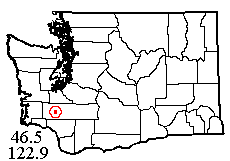 |
![]() 18 XI 2008: The first trip to one of my sites scouted from Amtrak train took place on a day with a forecast of fog, some clearing, and a small chance of rain. I got up to find it had rained heavily in Seattle before dawn. But a stop at the computer showed no rain in Chehalis or Castle Rock, so we took a chance. Gloomy and threatening skies dominated until we got to wonderful Lewis County, where (as has happened before) it cleared up and looked nice and dry. Our site, in a broad strip of right-of-way between the tracks and a farm road, was easy to find. I'd thought this might be a natural remnant of Napavine Prairie, but I wasn't so sure after we saw the apple trees! Lots of them, that had dropped all their leaves but still had loads of luscious fruit, yum! However, aside from these and a bit of Scots broom, the vegetation was fairly natural. Laurel and I both swept grass, bracken and shrubs, netting 12 species including a nice series of the shield-backed microspider Ceraticelus vesperus and surprising numbers of our state's one lynx spider. Laurel's collection from fir foliage included perhaps my longest series of rare Linyphantes eureka to date. The four different kinds of litter sifted (apple, alder, grass, maple) each produced distinctive species, the best specimen being a Clubiona mutata from the alder. The 34 species didn't include the state record we were hoping for, but it was pleasant and productive anyway, and Laurel's car made it over 100,000 miles on a field trip, just as she'd hoped. Leaving the site, we discovered it was in the purlieus of the hamlet of Evaline, which (having blinked) we missed on the way in!
18 XI 2008: The first trip to one of my sites scouted from Amtrak train took place on a day with a forecast of fog, some clearing, and a small chance of rain. I got up to find it had rained heavily in Seattle before dawn. But a stop at the computer showed no rain in Chehalis or Castle Rock, so we took a chance. Gloomy and threatening skies dominated until we got to wonderful Lewis County, where (as has happened before) it cleared up and looked nice and dry. Our site, in a broad strip of right-of-way between the tracks and a farm road, was easy to find. I'd thought this might be a natural remnant of Napavine Prairie, but I wasn't so sure after we saw the apple trees! Lots of them, that had dropped all their leaves but still had loads of luscious fruit, yum! However, aside from these and a bit of Scots broom, the vegetation was fairly natural. Laurel and I both swept grass, bracken and shrubs, netting 12 species including a nice series of the shield-backed microspider Ceraticelus vesperus and surprising numbers of our state's one lynx spider. Laurel's collection from fir foliage included perhaps my longest series of rare Linyphantes eureka to date. The four different kinds of litter sifted (apple, alder, grass, maple) each produced distinctive species, the best specimen being a Clubiona mutata from the alder. The 34 species didn't include the state record we were hoping for, but it was pleasant and productive anyway, and Laurel's car made it over 100,000 miles on a field trip, just as she'd hoped. Leaving the site, we discovered it was in the purlieus of the hamlet of Evaline, which (having blinked) we missed on the way in!
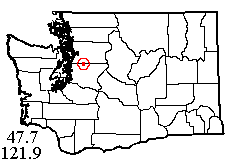 |
5 XII 2008: A rare day of fine collecting weather found Laurel with other commitments, so I took a bus trip to a "fill-in" site near the town of Duvall in east King County. It was a powerline right-of-way, usually the spider collector's friend – providing public access and decent habitat in areas otherwise without these things. But my mortal enemies, cutleaf and Himalayan blackberry, had invaded this one rather heavily. These particular vines were more than usually diabolical; I'd step on one and it would whip around and get me from behind. My screams were reminiscent of those in a lurid horror movie we'd watched two nights before. Beyond that, they'd swallowed much good habitat and blocked my access to the forest areas beside the powerline. And despite the dry weather, much of the habitat was pretty wet, perhaps due to heavy dew. I started by sifting 3 species from moss, then got only 2 from salmonberry-alder litter (too wet for efficient sifting). The less soggy litter under a cedar tree (the only one I could reach through the briars) was considerably better, producing 9 spider species and other good things. I found some sweepable grass and got another 9 species, including the one surprise of the trip, 4 females of a linyphiid species I haven't yet placed to genus. There are still new things to be found, even in disturbed habitats! Grass litter yielded almost nothing (no doubt it was too wet). At dusk I beat 5 species (which I had to remove my glasses to see in the dim light) from my one cedar tree. Waiting for my return bus, I filled the time by beating some juniper shrubs along the public right of way, and got the uncommon orbweaver Zygiella atrica plus 3 other additions to the list. So, even with several strikes (and many thorns) against me I got 27 species, 29 with some old prior records. If it doesn't rain, it's hard to go wrong with fall spider collecting.
Further fall collecting was stymied by cold and snow— stay tuned for 2009!
This page last updated 21 March, 2025